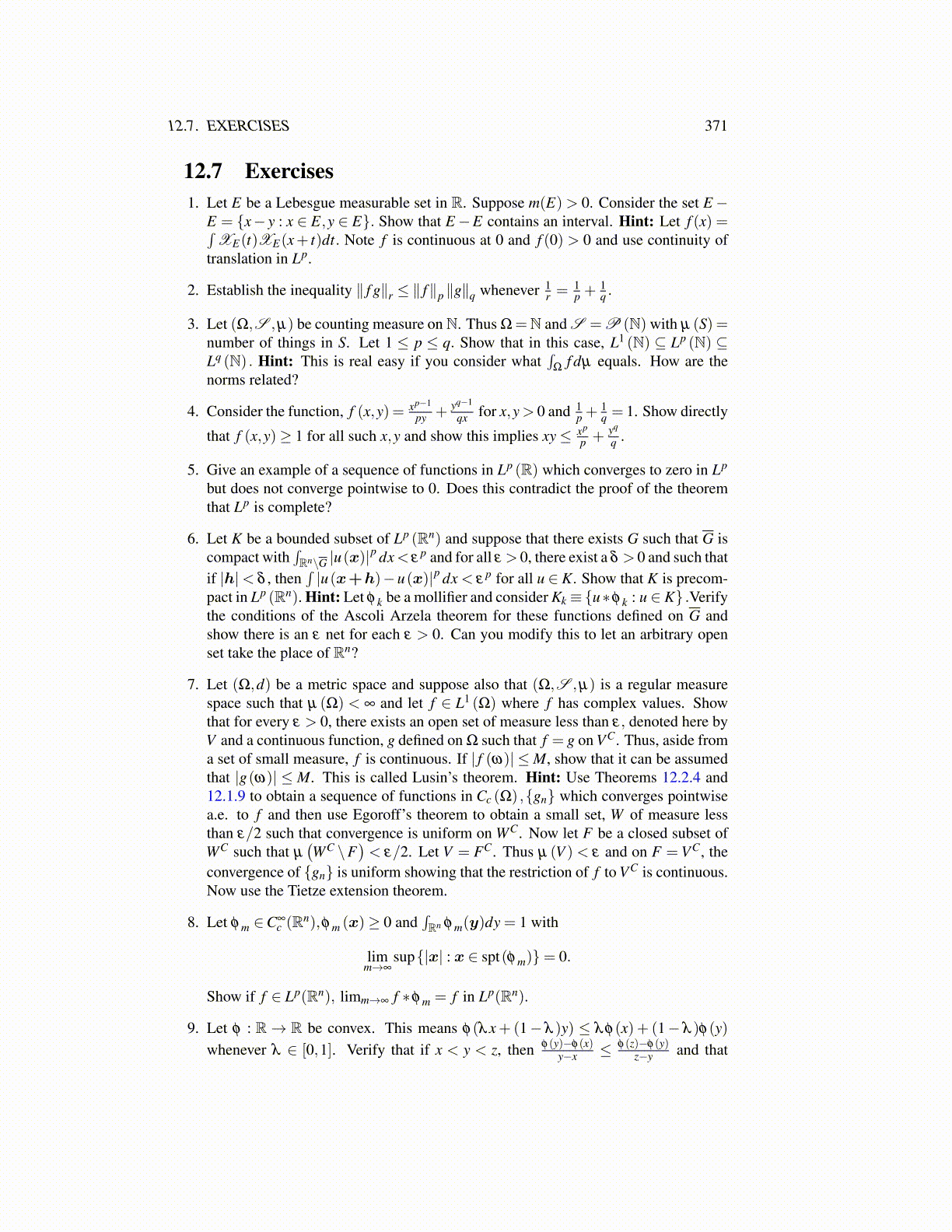
12.7. EXERCISES 371
12.7 Exercises1. Let E be a Lebesgue measurable set in R. Suppose m(E)> 0. Consider the set E−
E = {x− y : x ∈ E,y ∈ E}. Show that E−E contains an interval. Hint: Let f (x) =∫XE(t)XE(x+ t)dt. Note f is continuous at 0 and f (0) > 0 and use continuity of
translation in Lp.
2. Establish the inequality ∥ f g∥r ≤ ∥ f∥p ∥g∥q whenever 1r = 1
p +1q .
3. Let (Ω,S ,µ) be counting measure onN. Thus Ω =N and S =P (N) with µ (S) =number of things in S. Let 1 ≤ p ≤ q. Show that in this case, L1 (N) ⊆ Lp (N) ⊆Lq (N) . Hint: This is real easy if you consider what
∫Ω
f dµ equals. How are thenorms related?
4. Consider the function, f (x,y) = xp−1
py + yq−1
qx for x,y> 0 and 1p +
1q = 1. Show directly
that f (x,y)≥ 1 for all such x,y and show this implies xy≤ xp
p + yq
q .
5. Give an example of a sequence of functions in Lp (R) which converges to zero in Lp
but does not converge pointwise to 0. Does this contradict the proof of the theoremthat Lp is complete?
6. Let K be a bounded subset of Lp (Rn) and suppose that there exists G such that G iscompact with
∫Rn\G |u(x)|
p dx< ε p and for all ε > 0, there exist a δ > 0 and such thatif |h|< δ , then
∫|u(x+h)−u(x)|p dx < ε p for all u ∈ K. Show that K is precom-
pact in Lp (Rn). Hint: Let φ k be a mollifier and consider Kk ≡{u∗φ k : u ∈ K} .Verifythe conditions of the Ascoli Arzela theorem for these functions defined on G andshow there is an ε net for each ε > 0. Can you modify this to let an arbitrary openset take the place of Rn?
7. Let (Ω,d) be a metric space and suppose also that (Ω,S ,µ) is a regular measurespace such that µ (Ω) < ∞ and let f ∈ L1 (Ω) where f has complex values. Showthat for every ε > 0, there exists an open set of measure less than ε, denoted here byV and a continuous function, g defined on Ω such that f = g on VC. Thus, aside froma set of small measure, f is continuous. If | f (ω)| ≤M, show that it can be assumedthat |g(ω)| ≤ M. This is called Lusin’s theorem. Hint: Use Theorems 12.2.4 and12.1.9 to obtain a sequence of functions in Cc (Ω) ,{gn} which converges pointwisea.e. to f and then use Egoroff’s theorem to obtain a small set, W of measure lessthan ε/2 such that convergence is uniform on WC. Now let F be a closed subset ofWC such that µ
(WC \F
)< ε/2. Let V = FC. Thus µ (V ) < ε and on F = VC, the
convergence of {gn} is uniform showing that the restriction of f to VC is continuous.Now use the Tietze extension theorem.
8. Let φ m ∈C∞c (Rn),φ m (x)≥ 0 and
∫Rn φ m(y)dy = 1 with
limm→∞
sup{|x| : x ∈ spt(φ m)}= 0.
Show if f ∈ Lp(Rn), limm→∞ f ∗φ m = f in Lp(Rn).
9. Let φ : R→ R be convex. This means φ(λx+ (1− λ )y) ≤ λφ(x) + (1− λ )φ(y)whenever λ ∈ [0,1]. Verify that if x < y < z, then φ(y)−φ(x)
y−x ≤ φ(z)−φ(y)z−y and that